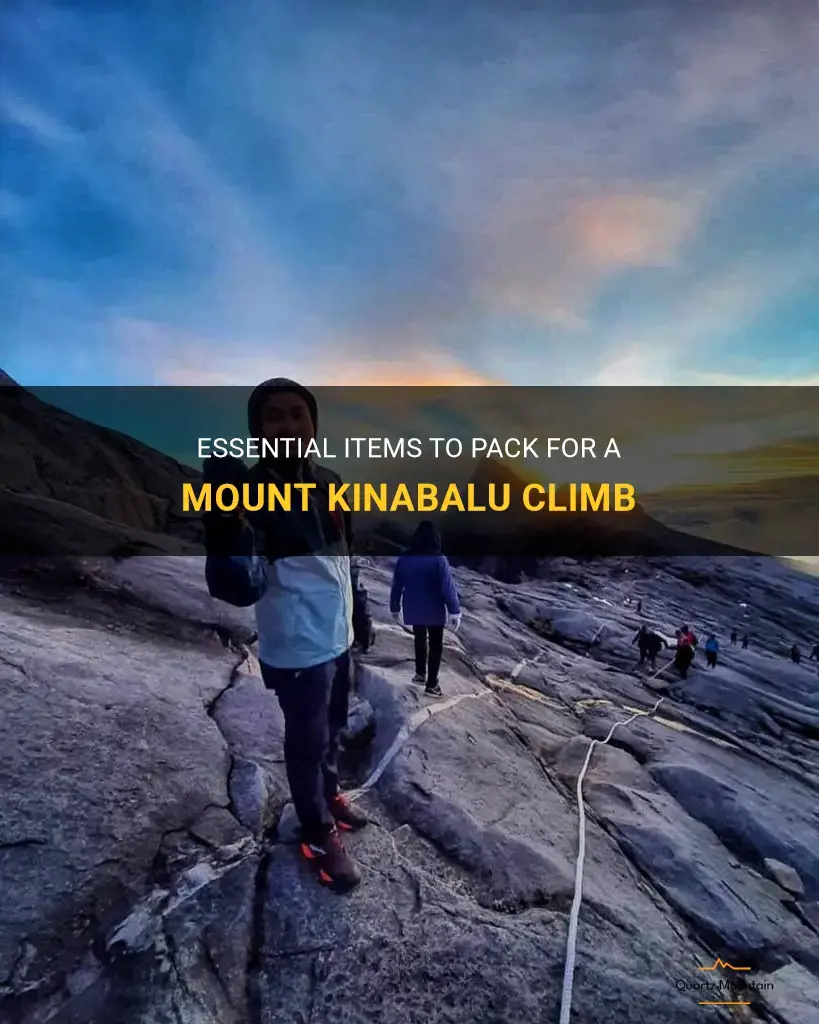
Are you planning to conquer the majestic Mount Kinabalu? As you embark on this extraordinary adventure, it is crucial to ensure you have all the essential items packed for a smooth and comfortable climb. From sturdy hiking boots to warm clothing and portable snacks, this guide will walk you through the must-have items that will make your Mount Kinabalu climb an unforgettable experience. So, grab your backpack, lace up your boots, and get ready to conquer the highest peak in Southeast Asia!
What You'll Learn
- What are the essential items that should be packed for a Mount Kinabalu climb?
- Are there any specific clothing or footwear requirements for a Mount Kinabalu climb?
- Should I bring my own sleeping bag and sleeping mat for the climb, or are they provided?
- Are there any specific medications or first aid supplies that should be included in my packing list for a Mount Kinabalu climb?
- Is there any specialized equipment, such as climbing harnesses or crampons, that are required for the Mount Kinabalu climb?

What are the essential items that should be packed for a Mount Kinabalu climb?
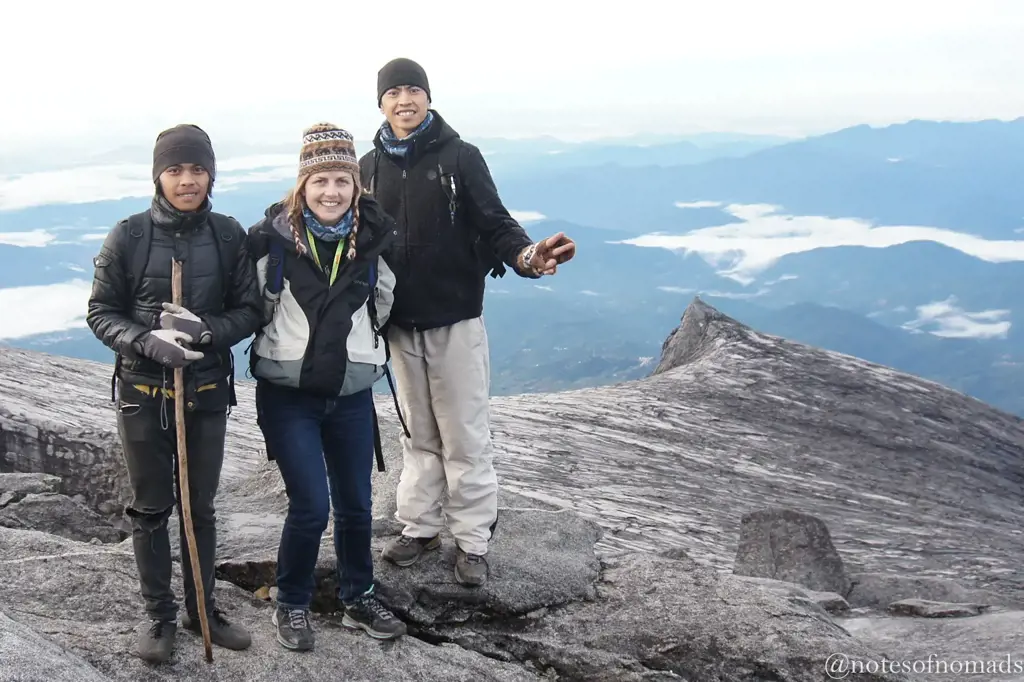
Mount Kinabalu, located in Sabah, Malaysia, is one of the most popular climbing destinations in Southeast Asia. Standing at 4,095 meters tall, it offers breathtaking views and an unforgettable hiking experience. However, before embarking on this challenging feat, it is important to pack the right gear and essentials to ensure a safe and comfortable climb.
- Hiking Boots: A good pair of hiking boots is essential for a Mount Kinabalu climb. The terrain can be rocky and slippery, so it is important to have sturdy boots that provide ankle support and grip.
- Layered Clothing: The weather on Mount Kinabalu can be unpredictable, with temperatures dropping significantly at higher elevations. It is recommended to bring layered clothing that can be easily added or removed as needed. A waterproof and windproof jacket is also essential to protect against rain and wind.
- Backpack: A durable and comfortable backpack is necessary to carry all your essentials during the climb. It should have enough capacity to hold your clothing, snacks, water, and other personal items. Make sure it has padded straps and a waist belt for extra support.
- Water and Snacks: Staying hydrated is crucial during the climb. Bring at least two liters of water in a refillable water bottle or hydration bladder. High-energy snacks such as trail mix, granola bars, and fruits are also important to keep your energy levels up.
- Headlamp: A headlamp is essential for early morning hikes, as you will start the ascent before sunrise to catch the stunning sunrise from the summit. Make sure to bring extra batteries as well.
- Trekking Poles: Trekking poles can provide stability and support during the climb, especially on steep and slippery sections. They help to reduce the impact on your knees and improve balance.
- Essential Medications: It is important to bring any necessary medications, such as altitude sickness medication, pain relievers, and band-aids for blisters. Consult with your doctor before the climb to ensure you have the appropriate medications.
- Warm Hat and Gloves: As temperatures drop at higher altitudes, a warm hat and gloves are essential for staying warm. Opt for thermal or fleece materials that provide insulation.
- Sun Protection: The sun can be intense, even at higher altitudes. Bring sunscreen with a high SPF, sunglasses, and a wide-brimmed hat to protect your skin and eyes from the harsh UV rays.
- Camera: Last but not least, don't forget to bring a camera or smartphone to capture the breathtaking views from the summit. Mount Kinabalu offers stunning panoramic views and unique flora and fauna that you wouldn't want to miss.
In conclusion, packing the right gear and essentials for a Mount Kinabalu climb is crucial for a safe and enjoyable experience. Make sure to invest in good quality hiking boots, layered clothing, a comfortable backpack, and other necessary items such as water, snacks, a headlamp, trekking poles, essential medications, warm hat and gloves, sun protection, and a camera. With the right equipment, you can fully enjoy the beauty and challenges of climbing Mount Kinabalu.
Creative Cold Lunch Ideas: What to Pack When There's No Microwave
You may want to see also

Are there any specific clothing or footwear requirements for a Mount Kinabalu climb?
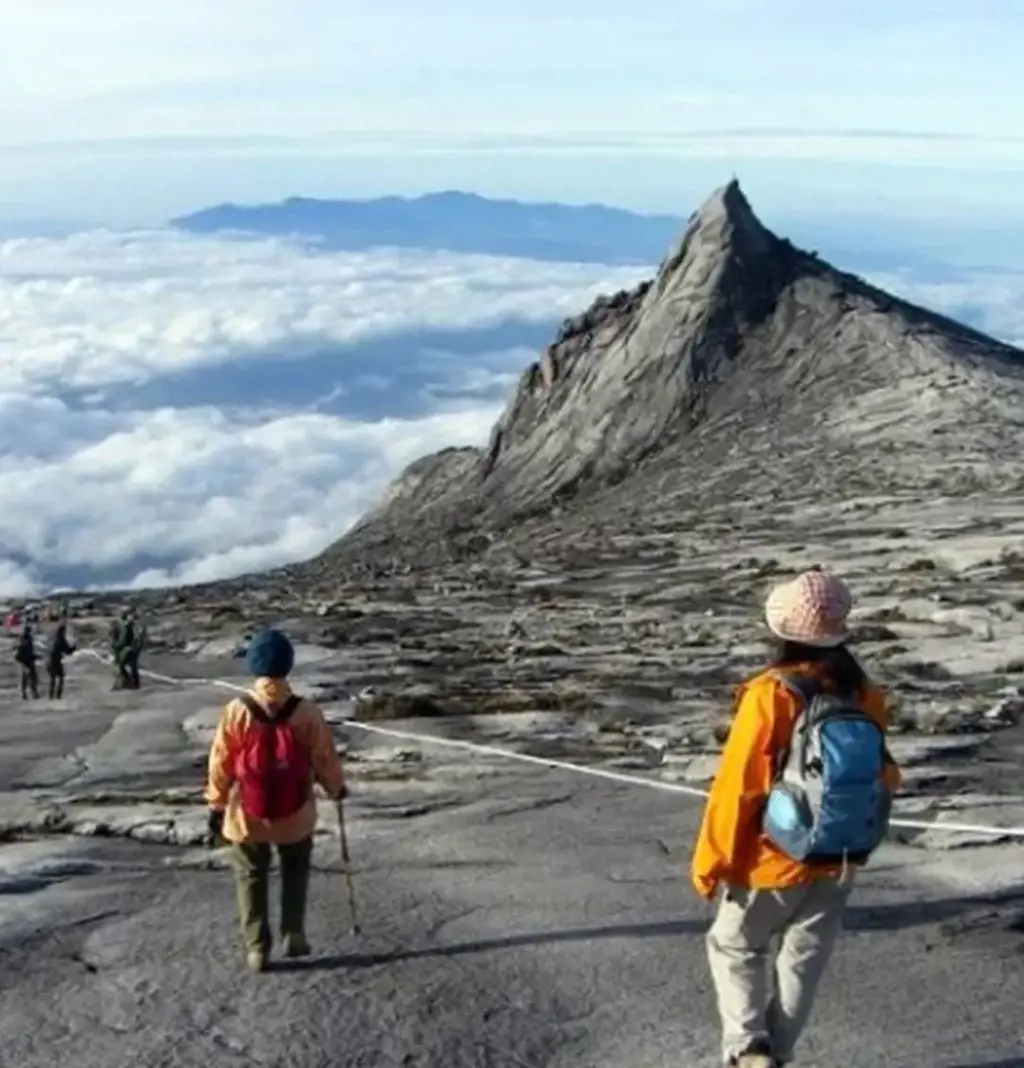
Climbing Mount Kinabalu, located in the Kinabalu National Park in Sabah, Malaysia, is a popular adventure among outdoor enthusiasts. Before embarking on this challenging journey, it is crucial to consider the clothing and footwear requirements to ensure a safe and comfortable climb.
Layering is essential:
Mount Kinabalu stands at an elevation of 4,095 meters (13,435 feet), and the weather conditions can vary dramatically throughout the day. It is recommended to dress in layers, so you can easily adjust your clothing according to the changing temperatures. Start with a moisture-wicking base layer, followed by a lightweight insulating layer, and finally, a waterproof and windproof outer layer.
Moisture-wicking clothing:
When climbing Mount Kinabalu, you are likely to encounter varying weather conditions, including rain and fog. It is crucial to wear moisture-wicking clothing that will keep you dry and comfortable. Avoid cotton as it retains moisture, which can lead to discomfort and even hypothermia in cooler temperatures.
Insulation is key:
The temperatures on Mount Kinabalu can drop significantly, especially at higher altitudes. To stay warm, it is important to wear appropriate insulation. Fleece jackets, thermal tops, and pants provide excellent insulation without adding too much weight to your pack. Consider packing a down jacket as well for added warmth during colder periods.
Waterproof and windproof outer layer:
A high-quality waterproof and windproof jacket and pants are essential for keeping you dry and protected from the elements. Look for gear with sealed seams and adjustable hoods to ensure maximum protection. Additionally, lightweight rain covers for your backpack and waterproof gloves can also be beneficial.
Comfortable and sturdy footwear:
Choosing the right footwear is crucial for a successful climb. Invest in a sturdy pair of hiking boots or shoes that provide ankle support and have a good grip on different terrains. Make sure they are well broken-in before your climb to prevent blisters and discomfort. Additionally, consider packing extra socks to keep your feet dry and comfortable throughout the climb.
Accessories for added comfort:
To protect yourself from the sun, bring a wide-brimmed hat or a cap and sunglasses. Sunscreen with a high SPF and lip balm with UV protection are also essential to prevent sunburn. Don't forget to pack a warm beanie or hat to keep your head warm during colder temperatures.
In conclusion, when preparing for a Mount Kinabalu climb, it is essential to dress appropriately to tackle the varying weather conditions. Layering, moisture-wicking clothing, insulation, waterproof and windproof outer layers, comfortable footwear, and essential accessories will ensure your comfort and safety during your climb. By following these clothing and footwear requirements, you are setting yourself up for a successful and enjoyable Mount Kinabalu adventure.
The Essential Checklist for Packing for a Disneyland Vacation
You may want to see also

Should I bring my own sleeping bag and sleeping mat for the climb, or are they provided?
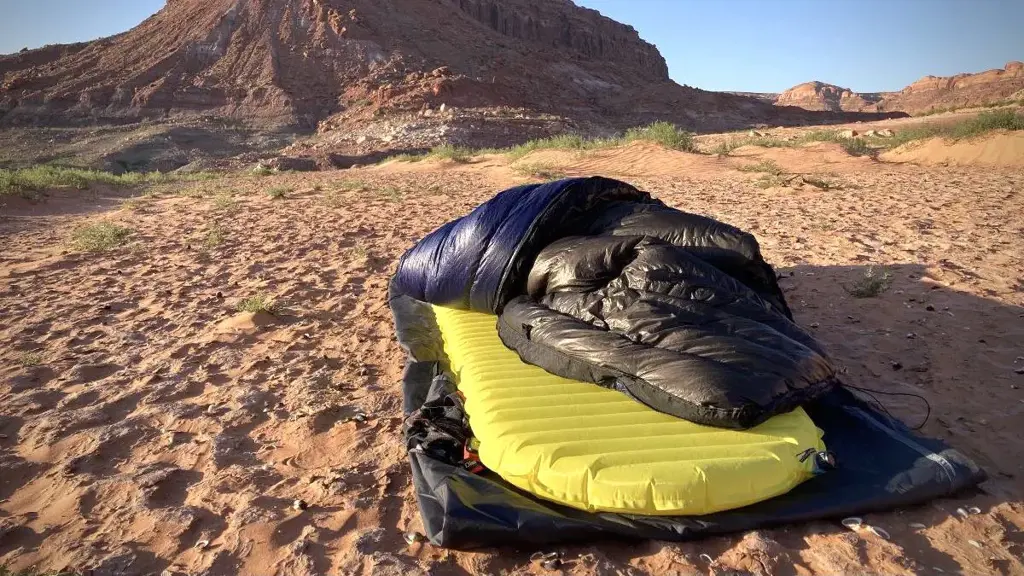
When embarking on a climb, it is crucial to be well-prepared and equipped with the necessary gear to ensure a safe and comfortable journey. One common question that climbers often ask is whether they should bring their own sleeping bag and sleeping mat or if they will be provided at the climbing site. In most cases, it is recommended to bring your own sleeping bag and sleeping mat for several reasons.
Firstly, bringing your own sleeping bag allows you to choose one that suits your needs and preferences. Sleeping bags come in various shapes, sizes, and insulation types, each offering different levels of comfort and warmth. By selecting a sleeping bag that you are accustomed to, you can ensure that you will have a good night's sleep, even in challenging conditions. Additionally, using your own sleeping bag reduces the risk of sharing it with others, thereby minimizing the chances of spreading bacteria or viruses.
Secondly, bringing your own sleeping mat provides extra comfort and insulation during the climb. Sleeping directly on the ground can be uncomfortable, especially if the terrain is rocky or uneven. A sleeping mat provides a soft and cushioned surface, making it easier to fall asleep and stay rested throughout the night. Moreover, a sleeping mat acts as an insulating layer, preventing the cold ground from sapping away your body heat. This is particularly important in colder climates or at high altitudes, where the temperature drops significantly during the night.
In some cases, particularly on organized climbing expeditions, sleeping bags and sleeping mats may be provided. However, it is important to consider the quality and suitability of the provided gear. Shared sleeping bags might not be as clean as you would like, increasing the risk of discomfort and germs. Furthermore, the provided sleeping mats may not offer the same level of insulation or comfort as those you bring from home. Therefore, it is still advisable to bring your own sleeping bag and sleeping mat, even if they are supplied.
To ensure that you have the right gear for the climb, consider the climate and weather conditions of the area you are visiting. If you are climbing in a hot and tropical location, a lighter sleeping bag may be sufficient. On the other hand, if you are tackling a snow-covered mountain, a heavy-duty sleeping bag designed for extreme temperatures will be necessary. Similarly, the choice of sleeping mat should also be based on the terrain and weather conditions. Some mats are designed specifically for rocky surfaces, while others provide extra insulation against the cold.
In conclusion, it is generally recommended to bring your own sleeping bag and sleeping mat for a climb, rather than relying on provided gear. Your own sleeping bag allows you to choose one that suits your preferences and reduces the risk of sharing with others. Moreover, having your own sleeping mat provides extra comfort and insulation, ensuring a restful sleep throughout the climb. However, it is important to consider the climate and terrain of the climbing site when selecting the appropriate gear. By being well-prepared with your own sleeping bag and sleeping mat, you can enjoy a comfortable and safe climb.
Essential Items to Pack for a Winter Adventure in the Kalahari
You may want to see also

Are there any specific medications or first aid supplies that should be included in my packing list for a Mount Kinabalu climb?

Climbing Mount Kinabalu, located in Sabah, Malaysia, is an exhilarating adventure that requires careful preparation. As with any outdoor activity, it is important to be prepared for any unforeseen circumstances, especially when it comes to health and safety. In this article, we will discuss the specific medications and first aid supplies that should be included in your packing list for a Mount Kinabalu climb.
Before we delve into the specific items, it is important to note that climbing Mount Kinabalu is a physically demanding activity that may cause altitude sickness and other minor injuries. The 4,095-meter (13,435 ft) peak is one of the highest in Southeast Asia, and it is necessary to acclimatize properly to avoid potential health risks. It is recommended to consult with a healthcare professional before attempting any high-altitude activities.
Now let's move on to the medications and first aid supplies that should be included in your packing list:
- Altitude sickness medication: Acetazolamide (brand name Diamox) is a commonly prescribed medication for preventing and treating altitude sickness. It helps your body acclimatize to the high altitude more efficiently. It is advisable to start taking this medication a day or two before your climb and continue taking it until you descend from the mountain.
- Pain relievers: Climbing Mount Kinabalu involves significant physical exertion, and it is not uncommon to experience muscle aches and pains. Packing pain relievers such as ibuprofen or acetaminophen can help alleviate discomfort during and after the climb.
- Anti-diarrhea medication: Traveler's diarrhea is a common problem in many parts of the world, including Southeast Asia. It is a good idea to pack an over-the-counter anti-diarrhea medication such as loperamide in case of stomach upset during the climb.
- Antiseptic ointment and bandages: Minor cuts and scrapes can happen during the climb, and it is important to keep them clean and protected to prevent infection. Packing antiseptic ointment and a variety of bandages can help you take care of any wounds that may occur.
- Blister prevention and treatment: Hiking boots that are not properly broken in can easily cause blisters. Packing blister prevention products such as moleskin or blister patches can help reduce the risk of developing blisters. Additionally, carrying blister treatment supplies such as adhesive bandages and antiseptic wipes can help in case blisters do occur.
- Sunscreen and lip balm: Mount Kinabalu's high altitude exposes climbers to increased sun radiation. It is important to protect your skin and lips from the sun's harmful rays by packing a high SPF sunscreen and lip balm.
- Insect repellent: Mosquitoes and other insects can be prevalent in the lower altitudes during the climb. Packing a DEET-based insect repellent can help protect you from bites and potential diseases, such as dengue fever or malaria.
In addition to these specific medications and first aid supplies, it is crucial to pack your regular medications if you have any chronic conditions. It is also advisable to bring a comprehensive first aid kit that includes items such as adhesive tape, scissors, tweezers, and sterile gauze pads.
Remember, these are just general recommendations, and it is always best to consult with a healthcare professional or travel medicine specialist for personalized advice based on your medical history and individual needs. Proper preparation and packing can go a long way in ensuring a safe and enjoyable climbing experience on Mount Kinabalu.
Tips for Packing for Your Oahu Adventure: Pinterest-inspired Ideas
You may want to see also

Is there any specialized equipment, such as climbing harnesses or crampons, that are required for the Mount Kinabalu climb?
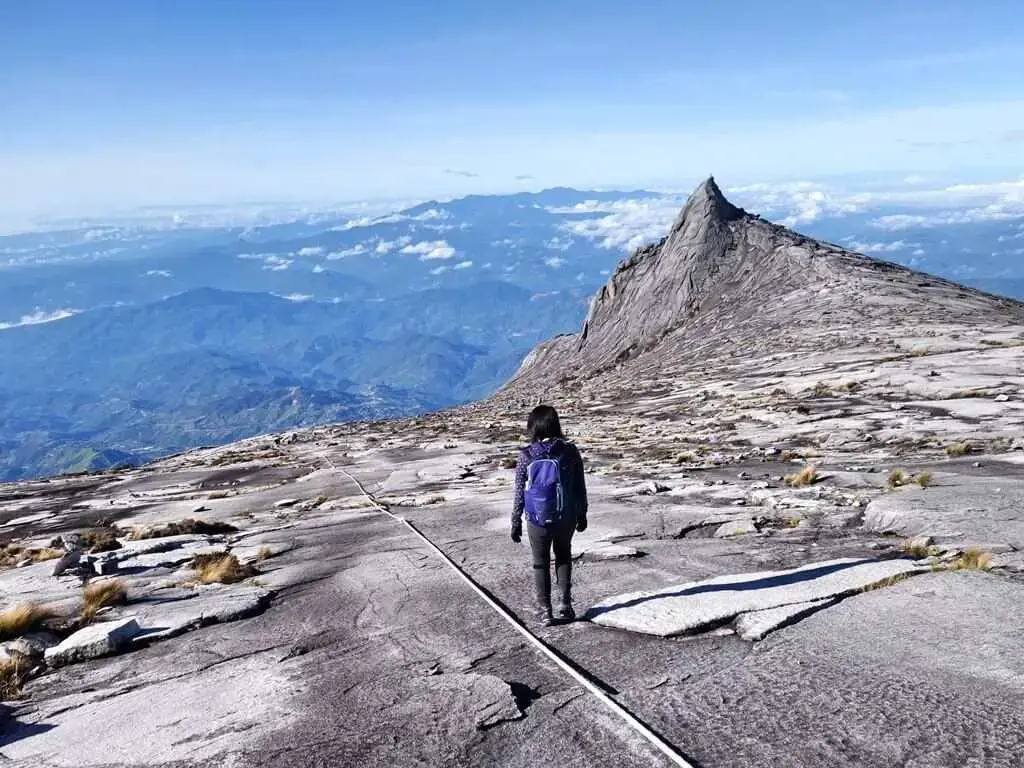
Mount Kinabalu, located in the state of Sabah in Malaysia, is one of the most popular peaks for climbers in Southeast Asia. Standing at an impressive height of 4,095 meters (13,435 feet), it offers breathtaking views and an exhilarating climbing experience. Many people wonder if there is any specialized equipment required for the Mount Kinabalu climb, such as climbing harnesses or crampons.
When it comes to climbing Mount Kinabalu, it is important to note that it is classified as a non-technical climb, meaning that you do not need any specialized climbing skills or equipment. However, there are certain essential items that climbers are required to have to ensure safety and comfort during the climb.
One of the most important pieces of equipment is a good pair of hiking boots. The terrain on Mount Kinabalu can be uneven and rocky, so it is crucial to have sturdy footwear that provides good ankle support. Waterproof boots are recommended, as there can be rain and muddy sections along the trail.
In addition to hiking boots, climbers are also required to have a backpack to carry their personal belongings, extra clothing layers, food, and water. It is important to pack light, as you will be carrying your backpack throughout the entire climb. Some climbers also opt to bring trekking poles, which can help provide stability and reduce strain on the knees during the descent.
As for clothing, it is important to wear layers as the temperature can vary significantly throughout the climb. A moisture-wicking base layer, such as a lightweight t-shirt or long-sleeved shirt, is recommended to keep you dry and comfortable. On top of that, a fleece or down jacket can provide insulation and warmth during cold weather. A waterproof and windproof jacket is also essential to protect against rain and strong winds.
In terms of accessories, it is recommended to bring a hat or cap, sunglasses, and sunscreen to protect against the sun's rays. Gloves can also be useful, especially during the early morning when temperatures can be quite chilly. You may also want to bring a headlamp or flashlight for the early morning climb to catch the sunrise.
While climbing harnesses and crampons are not required for the Mount Kinabalu climb, there are certain sections of the climb, such as the Via Ferrata route, where climbers can opt for additional challenges that require specialized equipment. The Via Ferrata is a system of iron rungs, cables, and bridges that allows climbers to scale the steep rock faces of Mount Kinabalu. If you plan to tackle the Via Ferrata, you will need to rent or bring your own climbing harness and other gear.
In conclusion, climbing Mount Kinabalu does not require any specialized equipment such as climbing harnesses or crampons. However, it is important to have a good pair of hiking boots, a backpack, and appropriate clothing layers to ensure a safe and comfortable climb. If you choose to undertake the Via Ferrata route, specialized equipment will be necessary. Always remember to consult with experienced climbers, guides, or tour operators before embarking on the climb to ensure that you have all the necessary equipment and are well-prepared for the adventure ahead.
Essential Items to Pack for Chemo Treatment: A Comprehensive Guide
You may want to see also
Frequently asked questions
When packing for your Mount Kinabalu climb, it's important to bring the essentials such as a sturdy pair of hiking boots, comfortable hiking socks, breathable and moisture-wicking clothing, a hat or cap to protect you from the sun, a waterproof jacket, and a backpack to carry your belongings. Additionally, you will also need to pack enough food and water for the duration of your climb, as well as any personal medication or first aid supplies you may need.
In addition to the basic essentials, there are a few other items you might want to consider packing for your Mount Kinabalu climb. These include a headlamp or flashlight for navigating in the dark, a pair of gloves to protect your hands during the colder sections of the climb, a set of dry bags or waterproof pouches to keep your belongings dry, and a set of trekking poles to provide extra stability and support on the steep and uneven terrain.
Yes, there are some restrictions on what you can bring with you on the Mount Kinabalu climb. For example, drones are not allowed on the mountain, so you will not be able to bring one with you. Additionally, there are restrictions on bringing certain items such as alcohol, cigarettes, and illegal drugs. It's also important to note that there are weight restrictions for the overnight climb, so you will need to pack as light as possible.
It's important to wear clothing that is comfortable and suitable for the changing weather conditions on the mountain. Layering is key, as it allows you to adjust your clothing as needed. Start with a moisture-wicking base layer, followed by a insulating mid-layer, and finish with a waterproof and windproof outer layer. It's also important to wear a good pair of hiking boots that are broken in and provide ankle support. Don't forget to wear a hat or cap to protect your head from the sun, and bring a pair of sunglasses to protect your eyes.







